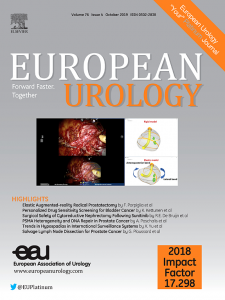局部前列腺癌治疗中尿路不良事件风险的演变:监测、流行病学和最终结果的倾向加权分析——医疗保险数据
IF 25.3
1区 医学
Q1 UROLOGY & NEPHROLOGY
引用次数: 0
摘要
前列腺癌治疗可导致长期泌尿不良事件(uae),但不同治疗的时变风险仍未得到充分研究。使用监测、流行病学和最终结果医疗保险数据,我们评估了2000年至2017年间接受根治性前列腺切除术(RP)、外束放疗(EBRT)、近距离治疗(BT)、EBRT + BT、RP + EBRT或消融治疗的年龄≥66岁的局限性前列腺癌男性。主要结局是需要手术的任何UAE,从治疗开始随访并在疾病进展时进行检查。Kaplan-Meier分析用于估计阿联酋累积发病率和倾向加权限制平均生存时间(RMST),以量化18年的平均无阿联酋生存率。该队列包括166581例患者:40%接受EBRT, 30% RP, 14% BT + EBRT, 12% BT, 3.1% RP + EBRT和1.7%消融。联合治疗风险最高,其他治疗方式表现出随时间的变化。在18岁时,RP + EBRT的阿联酋风险最高(41%),其次是BT + EBRT (35%), EBRT (29%), RP(23%)和BT(22%)。调整后的RMST为18年,RP + EBRT组最短(13.1年),BT +消融组最长(15.8年)。与RP(15.1年)相比,RP + EBRT的无uae生存期缩短了2.0年(RMST比0.87;p & lt;0.001), EBRT + BT缩短0.2年(RMST比0.99;p & lt;0.001)。肿瘤疗效和长期尿毒性之间的平衡是选择治疗方法的关键。本文章由计算机程序翻译,如有差异,请以英文原文为准。
Evolving Risk of Urinary Adverse Events Across Localized Prostate Cancer Treatments: A Propensity-weighted Analysis of Surveillance, Epidemiology and End Results-Medicare Data
Prostate cancer treatments can cause long-term urinary adverse events (UAEs), but time-varying risks across treatments remain understudied. Using Surveillance, Epidemiology and End Results-Medicare data, we evaluated men aged ≥66 yr with localized prostate cancer treated with radical prostatectomy (RP), external beam radiotherapy (EBRT), brachytherapy (BT), EBRT + BT, RP + EBRT, or ablation between 2000 and 2017. The primary outcome was any UAE requiring a procedure, with follow-up from treatment initiation and censoring at disease progression. Kaplan-Meier analysis was used to estimate the UAE cumulative incidence and the propensity-weighted restricted mean survival time (RMST) to quantify mean UAE-free survival at 18 yr. The cohort included 166 581 patients: 40% received EBRT, 30% RP, 14% BT + EBRT, 12% BT, 3.1% RP + EBRT, and 1.7% ablation. Combined therapy carried the highest risk, with other modalities showing time-dependent changes. At 18 yr, the UAE risk was highest for RP + EBRT (41%), followed by BT + EBRT (35%), EBRT (29%), RP (23%), and BT (22%). Adjusted RMST to 18 yr was shortest for RP + EBRT (13.1 yr) and longest for BT (15.8 yr) and ablation (15.6 yr). In comparison to RP (15.1 yr), UAE-free survival was 2.0 yr shorter with RP + EBRT (RMST ratio 0.87; p < 0.001) and 0.2 yr shorter with EBRT + BT (RMST ratio 0.99; p < 0.001). The balance between oncologic efficacy and long-term urinary toxicity is key to treatment selection.
求助全文
通过发布文献求助,成功后即可免费获取论文全文。
去求助
来源期刊

European urology
医学-泌尿学与肾脏学
CiteScore
43.00
自引率
2.60%
发文量
1753
审稿时长
23 days
期刊介绍:
European Urology is a peer-reviewed journal that publishes original articles and reviews on a broad spectrum of urological issues. Covering topics such as oncology, impotence, infertility, pediatrics, lithiasis and endourology, the journal also highlights recent advances in techniques, instrumentation, surgery, and pediatric urology. This comprehensive approach provides readers with an in-depth guide to international developments in urology.
 求助内容:
求助内容: 应助结果提醒方式:
应助结果提醒方式:


